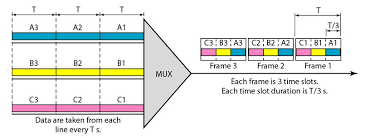Splitting up the bandwidth

© copyright myreadingroom.co.in

© copyright myreadingroom.co.in
Good site for details of how GSM works.
There is a limited amount of bandwidth available to the mobile phone operators and one of their requirements is to share their available 25MHz channels between users. There are three basic methods of sharing the available frequency; using FDMA (Frequency Division Multiple Access), TDMA (Time Division multiple Access), and CDMA (Code Division Multiple Access).
Frequency Division Multiple Access(In GSM communications) The available bandwidth that comes in 5MHz blocks and is split into 200KHz channels each separated from their neighbour. These separate channels allow for different users to access the bandwidth at the same time albeit with more limited (channel) bandwidth. This however can be wasteful in resources. There is space between frequencies that cannot be used due to potential interference; something that is solved with OFDMA. Additionally environment of uneven spread of demand, one channel may be busy whilst another is not well used. There is no ability to "share".
Time Division Multiple Access This is where the available time is split into time slots giving one user the whole of the spectrum, but for a limited time. After that the bandwith is given to the next user. This method of multiple access does allow sharing, the demand for the precious time on the channel is fairly shared between users. It does rely on precise synchronisation of the use of the channel.
Time and Frequency Division Multiple Access Together Wilst GSM is described as TDMA it is a mix of FDMA and TDMA. The frequency / time space is split into block and these are allocated in a fair mamer. Whilst this is complex it does allow for an efficient use of the precious resource in a fair way.
Code Division Multiple Access CDMA requires some processing power to make it work. The users are allocated a unique key which the user uses to code their data. then the calls are all transmitted at once. The receiver has the unique code and thus can decode the data back to the original
*u* ©mobilephonetechnology.co.uk all rights reserved 2017- 2025



